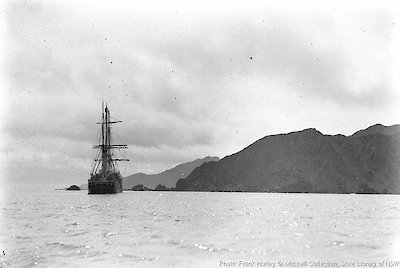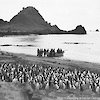Landfall
Aurora made slow work of the 832 nautical miles (1542 kilometres) from Hobart to Macquarie Island. Today’s ships make the distance in less than three days; for Aurora, heavy-laden, experiencing repeated squalls, and having to deal with an uncharted coast on arrival, it was nine days till landfall, early on 11 December.
Mawson’s first choice for a base was at Caroline Cove, at Macquarie’s southern end. He and a few others spent a few hours ashore, taking magnetic observations and establishing a cache of provisions. But it was deemed unsuitable — a decision reinforced by a near-miss when Aurora scraped an uncharted offshore rock. The ship headed north to where a low-lying isthmus linked a 100-metre hill to the island’s mainland.
The ship’s initial approach was via the anchorage normally used by sealers, ‘North-East Bay’ (now Buckles Bay). Men were seen ashore and tried to reach the ship by boat, but a steady easterly blow put them back on the beach. Aurora sailed around the headland to the western side, which at Davis’s suggestion was named Hasselborough Bay after the discoverer of the island.
Macquarie Island lies in the path of the Southern Ocean’s prevailing westerly gales. Easterlies are always something of a surprise — as was the case when a more recent Antarctic ship, Nella Dan, was forced on to rocks in Buckles Bay in 1987. For Mawson’s men, moderate easterlies continued for more than two weeks, throughout their time on the island.



